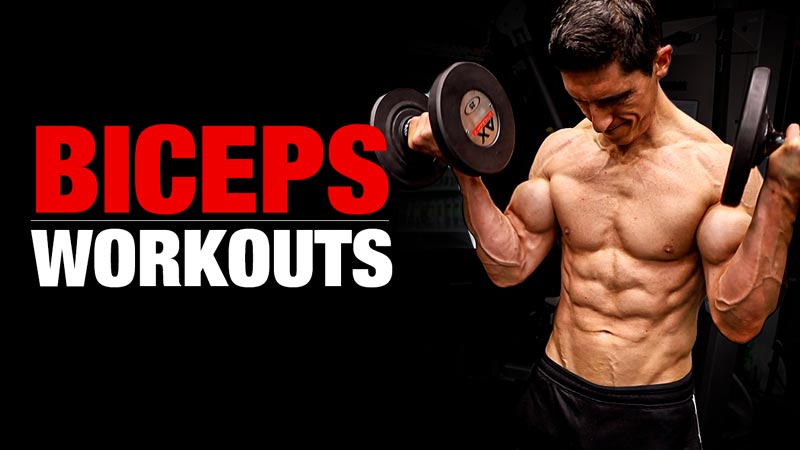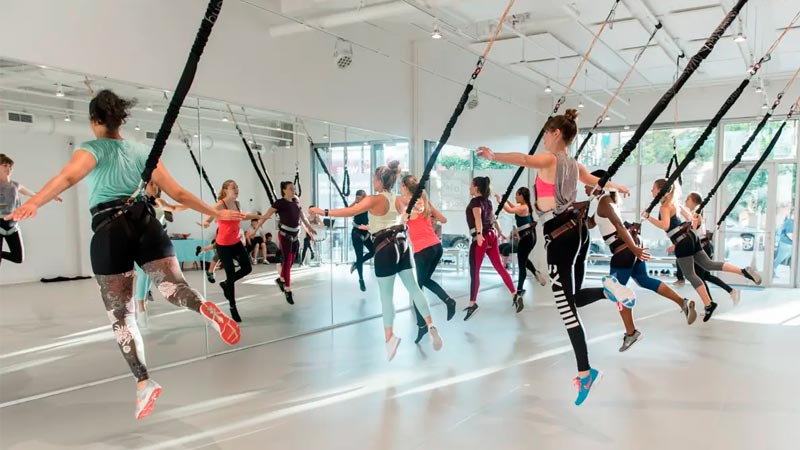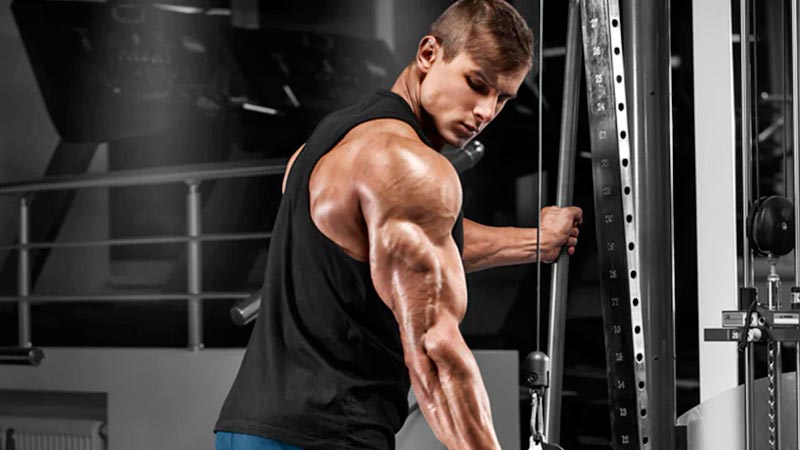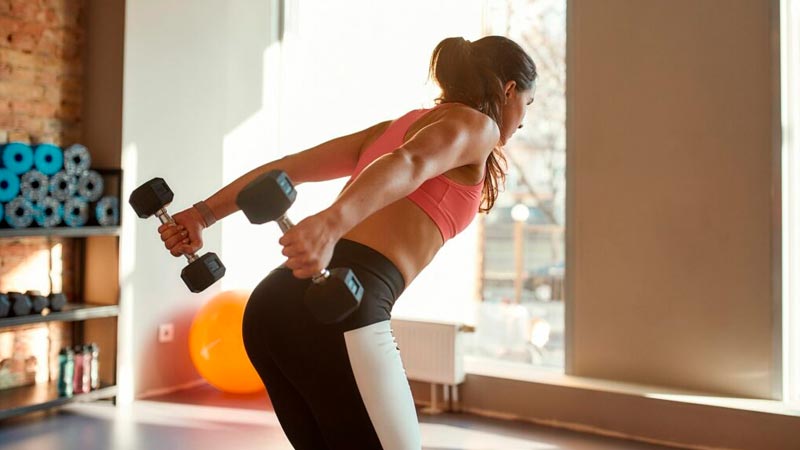Bicep Workouts are an essential part of upper body strength training. Building bigger biceps not only enhances the appearance of the arms but also contributes to overall strength and functionality.
Table of Contents
The biceps are a muscle group located in the front of the upper arm, responsible for flexing the elbow joint and rotating the forearm.
There are several exercises that effectively target the biceps, including curls, chin-ups, and hammer curls. These exercises can be performed with free weights, resistance bands, or machines.
It's important to vary the type of exercise and weight used to prevent plateauing and maximize results. Additionally, proper form and technique are crucial to avoid injury and ensure optimal muscle activation.
Bicep Anatomy
The biceps brachii muscle, commonly referred to as the biceps, is a two-headed muscle located in the upper arm. It is responsible for flexing the elbow joint and rotating the forearm. The two heads of the biceps are the long head and the short head.
The long head of the biceps originates from the supraglenoid tubercle of the scapula, while the short head originates from the coracoid process of the scapula. Both heads of the biceps insert into the radial tuberosity of the radius bone in the forearm.
The biceps muscle is surrounded by a fibrous sheath called the bicipital aponeurosis, which helps to stabilize the muscle during movement. The muscle is also innervated by the musculocutaneous nerve, which provides sensory and motor function to the biceps and surrounding muscles.
To effectively target the biceps during workouts, it is important to understand the different functions of the two heads. The long head of the biceps is responsible for shoulder flexion and is activated more during exercises that involve overhead movements, such as chin-ups or pull-ups. The short head of the biceps is responsible for elbow flexion and is activated more during exercises that involve curling movements, such as bicep curls or hammer curls.
Incorporating a variety of exercises that target both the long and short heads of the biceps can help to improve overall strength and muscle development in the upper arm.
Importance of Bicep Workouts
Bicep workouts are crucial for building upper body strength and aesthetics. The biceps are one of the most visible muscles in the body, and a well-developed pair of biceps can make a significant difference in one's appearance. However, there are more reasons to train biceps than just for looks.
Bicep workouts can help improve overall upper body strength. The biceps are involved in many upper body movements, such as pulling, lifting, and carrying. By strengthening the biceps, one can improve their ability to perform these movements and reduce the risk of injury.
In addition, bicep workouts can improve grip strength. Strong biceps are essential for gripping and holding objects, such as weights or tools. By training the biceps, one can improve their grip strength and overall hand dexterity.
Bicep workouts can also improve posture. Weak biceps can contribute to poor posture, as they are involved in maintaining proper shoulder alignment. By strengthening the biceps, one can improve their posture and reduce the risk of shoulder injuries.
Overall, bicep workouts are an essential part of any upper body training program. They can improve strength, aesthetics, grip strength, and posture. By incorporating bicep exercises into a workout routine, one can achieve a well-rounded and balanced upper body.
Warm-Up Exercises
Before starting any workout, it is essential to warm up your muscles to prevent injury and maximize your performance. This section will cover two warm-up exercises that are effective for bicep workouts.
Arm Circles
Arm circles are an excellent warm-up exercise for the shoulders and biceps. To perform this exercise, follow these steps:
- Stand straight with your feet shoulder-width apart.
- Extend your arms out to the sides, parallel to the ground.
- Start making small circles with your arms, gradually increasing the size of the circles.
- After 10-15 seconds, reverse the direction of the circles and continue for another 10-15 seconds.
- Repeat the exercise for two to three sets.
Performing arm circles will increase blood flow to your arms, shoulders, and upper back, preparing them for the bicep workout.
Wrist Stretch
The wrist stretch is an essential exercise to warm up the forearms and wrists. To perform this exercise, follow these steps:
- Extend your arm in front of you, palm facing down.
- Use your other hand to gently pull your fingers back towards your wrist.
- Hold the stretch for 10-15 seconds.
- Repeat the stretch on the other arm.
Performing wrist stretches will help prevent injury and increase flexibility in your wrists, allowing you to perform bicep exercises with proper form.
Incorporating these warm-up exercises into your bicep workout routine will help you get the most out of your workout and prevent injury.
Beginner Bicep Workouts
Standing Resistance Band Hammer Curl
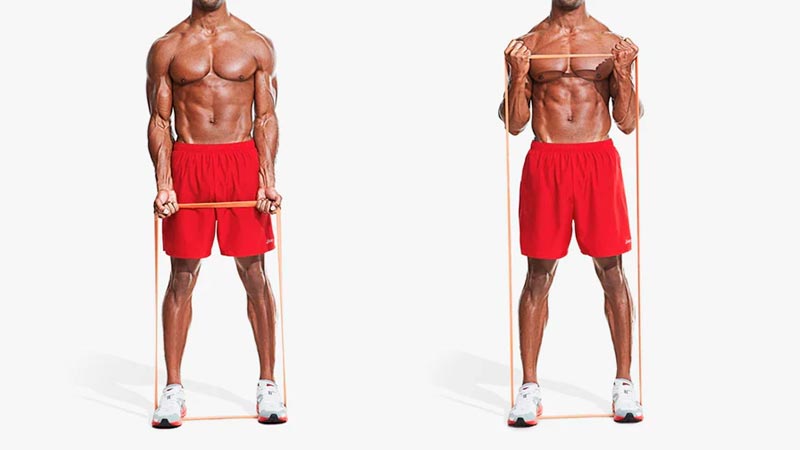
For beginners, the standing resistance band hammer curl is an excellent exercise to start with. This exercise targets the biceps and forearms. Here's how to perform it:
- Stand with your feet shoulder-width apart and place the resistance band under your feet.
- Hold the ends of the resistance band with your palms facing each other (hammer grip).
- Keep your elbows close to your body and curl the band up towards your shoulders.
- Slowly lower the band back down to the starting position.
- Repeat for 10-12 reps.
Seated Alternating Dumbbell Curl
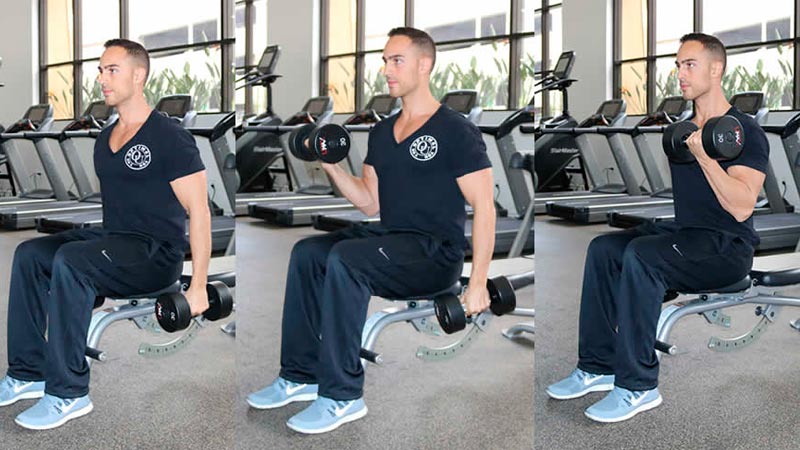
Another great exercise for beginners is the seated alternating dumbbell curl. This exercise targets the biceps and helps to improve overall arm strength. Here's how to perform it:
- Sit on a bench or chair with a dumbbell in each hand, palms facing forward.
- Keep your elbows close to your body and curl one dumbbell up towards your shoulder.
- Slowly lower the dumbbell back down to the starting position.
- Repeat with the other arm.
- Alternate arms for 10-12 reps.
Remember to start with a weight that is comfortable for you and gradually increase the weight as you become stronger. These exercises are a great way to start building your bicep muscles and improve your overall arm strength.
Intermediate Bicep Workouts
Standing Resistance Band Curl
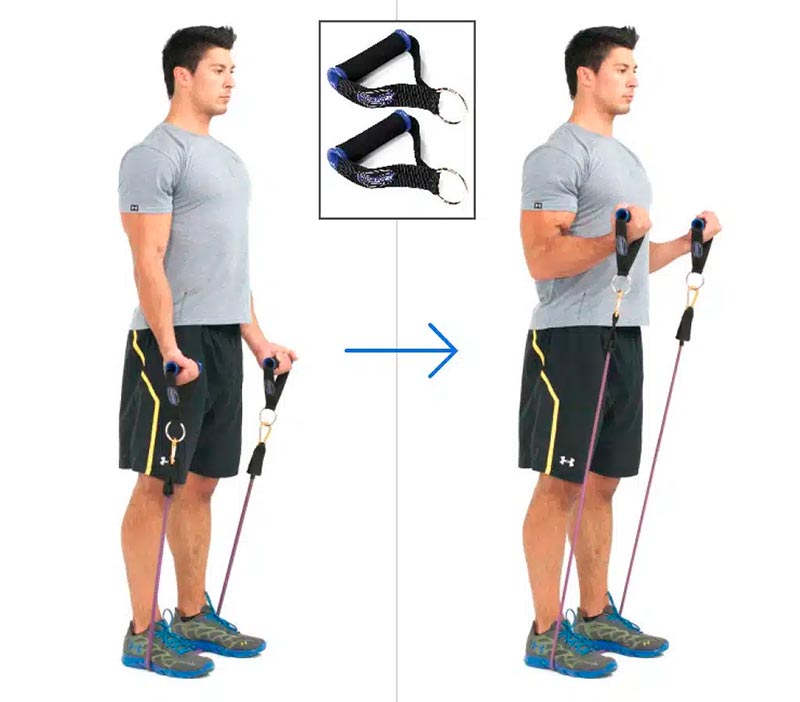
Standing resistance band curls are a great intermediate bicep workout. This exercise is perfect for those who have already mastered basic bicep exercises and are looking for a new challenge. Here is how to do it:
- Stand with your feet shoulder-width apart and place one end of the resistance band under your feet.
- Hold the other end of the band with your palms facing up and your arms fully extended.
- Slowly curl the band up towards your shoulders, keeping your elbows close to your body.
- Pause at the top of the movement and then slowly lower the band back down to the starting position.
Repeat this exercise for 3 sets of 12-15 reps.
Hammer Curl
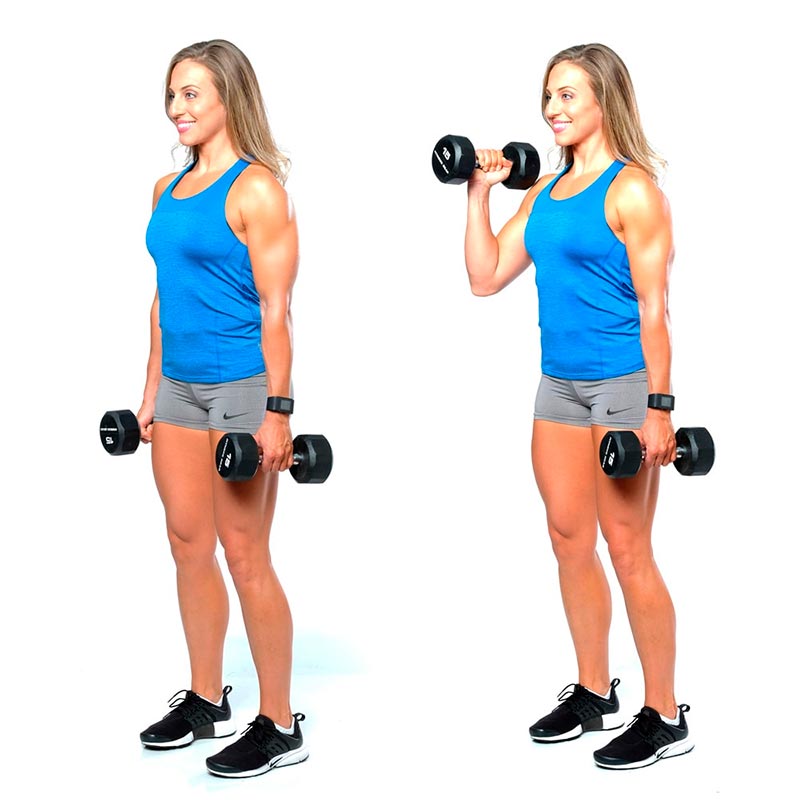
Hammer curls are another great intermediate bicep workout. This exercise targets both the biceps and the forearms. Here is how to do it:
- Stand with your feet shoulder-width apart and hold a dumbbell in each hand with your palms facing inwards.
- Keep your elbows close to your body and slowly curl the dumbbells up towards your shoulders.
- Pause at the top of the movement and then slowly lower the dumbbells back down to the starting position.
Repeat this exercise for 3 sets of 12-15 reps.
Remember to always warm up before starting any workout and to use proper form to avoid injury.
Advanced Bicep Workouts
Incline Dumbbell Curl
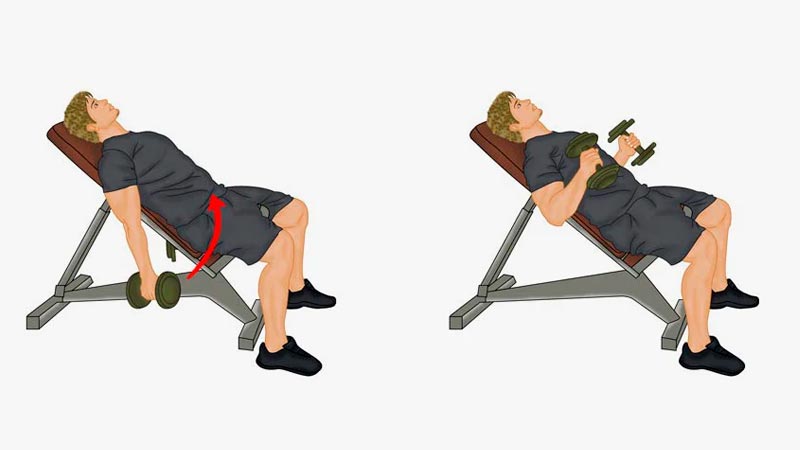
Incline dumbbell curls are an advanced bicep workout that targets the long head of the bicep muscle. To perform this exercise, the individual should sit on an incline bench with a dumbbell in each hand. The arms should be fully extended with the palms facing forward. The individual should then curl the dumbbells towards their shoulders, keeping the elbows close to the body, and then slowly lower the weight back to the starting position. It is important to maintain proper form throughout the exercise to avoid injury and maximize results.
Concentration Curl
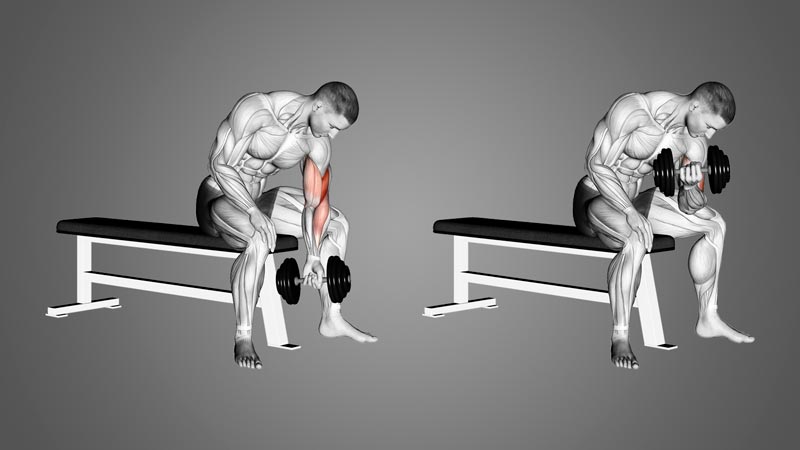
Concentration curls are another advanced bicep workout that targets the bicep muscle. To perform this exercise, the individual should sit on a bench with their legs spread apart and a dumbbell in one hand. The elbow should be rested on the inner thigh, and the arm should be fully extended with the palm facing upward. The individual should then curl the weight towards their shoulder, keeping the elbow close to the body, and then slowly lower the weight back to the starting position. This exercise should be repeated with the other arm.
Advanced bicep workouts like incline dumbbell curls and concentration curls can help individuals achieve their fitness goals. However, it is important to consult with a fitness professional before attempting these exercises to ensure proper form and technique.
Videos of Bicep Workouts
Proper Form and Techniques
Proper form and technique are crucial to getting the most out of your bicep workouts. Here are some tips to ensure that you are performing bicep exercises correctly:
1. Keep Your Elbows Stationary
When performing bicep curls or any other bicep exercise, it is important to keep your elbows stationary. This means that your upper arms should remain in the same position throughout the exercise. Moving your elbows can shift the focus away from your biceps and onto other muscles, such as your shoulders or back.
2. Use a Full Range of Motion
To get the most out of your bicep workouts, it is important to use a full range of motion. This means that you should fully extend your arms at the bottom of the exercise and fully contract your biceps at the top of the exercise. Using a full range of motion ensures that you are working your biceps through their entire range of motion, which can help to increase muscle growth and strength.
3. Control the Weight
When performing bicep exercises, it is important to control the weight throughout the entire movement. This means that you should not swing the weight or use momentum to lift the weight. Instead, focus on using your biceps to lift the weight and control the weight on the way down.
4. Don't Overdo It
While it is important to challenge yourself during your bicep workouts, it is also important not to overdo it. Overtraining your biceps can lead to injury and can also hinder your progress. It is recommended to perform bicep exercises 1-2 times per week, with at least 48 hours of rest between workouts.
By following these tips, you can ensure that you are performing bicep exercises correctly and getting the most out of your workouts.
Common Bicep Workout Mistakes
When it comes to bicep workouts, there are several common mistakes that people make. These mistakes can lead to injury, slow progress, and frustration. In this section, we will discuss some of the most common bicep workout mistakes and how to avoid them.
Using Too Much Weight
One of the most common mistakes people make when doing bicep workouts is using too much weight. This can lead to poor form, which can cause injury and slow progress. It's important to choose a weight that allows you to maintain proper form throughout the exercise. If you find that you're struggling to complete the exercise with proper form, it's time to decrease the weight.
Not Using Full Range of Motion
Another common mistake is not using a full range of motion. This means that you're not fully extending your arms or fully contracting your biceps during the exercise. This can lead to limited progress and poor muscle development. Make sure to use a full range of motion during your bicep workouts to get the most out of your exercises.
Neglecting Other Muscle Groups
Many people focus solely on bicep workouts and neglect other muscle groups. This can lead to muscle imbalances and poor overall strength. It's important to incorporate exercises that target other muscle groups, such as the back and shoulders, into your workout routine. This will help to ensure that you're building a balanced physique and reducing your risk of injury.
Overtraining
Overtraining is another common mistake that people make when doing bicep workouts. This means that you're working out too frequently or for too long, which can lead to injury and slow progress. It's important to give your muscles time to rest and recover between workouts. Aim to work out your biceps no more than twice per week.
Conclusion
By avoiding these common bicep workout mistakes, you can ensure that you're making progress and reducing your risk of injury. Remember to choose a weight that allows you to maintain proper form, use a full range of motion, incorporate exercises that target other muscle groups, and avoid overtraining. With these tips in mind, you'll be on your way to building strong, defined biceps.
Post-Workout Recovery Tips
After a strenuous bicep workout, it's important to allow your muscles to recover properly. Here are some post-workout recovery tips that can help you maximize your gains and minimize your risk of injury:
1. Hydrate
Drinking plenty of water before, during, and after your workout can help prevent dehydration and aid in muscle recovery. Aim to drink at least 8-10 glasses of water per day, and more if you're sweating heavily during your workout.
2. Stretch
Stretching post-workout can help prevent muscle soreness and improve flexibility. Focus on stretching your biceps, shoulders, and chest muscles for optimal recovery.
3. Rest
Giving your muscles time to rest and recover is crucial for building strength and avoiding injury. Aim to get 7-9 hours of sleep per night and avoid overtraining your biceps by allowing them at least 48 hours of rest between workouts.
4. Eat a Balanced Diet
Eating a balanced diet rich in protein, carbohydrates, and healthy fats can help support muscle recovery. Aim to eat a meal containing protein and carbohydrates within 30 minutes of completing your workout to aid in muscle repair.
5. Use Foam Rollers
Using a foam roller to massage your biceps and surrounding muscles can help increase blood flow and aid in muscle recovery. Roll out any tight or sore areas for 1-2 minutes per muscle group.
By following these post-workout recovery tips, you can help ensure that your biceps are recovering properly and that you're getting the most out of your workouts.
Conclusion
In conclusion, bicep workouts are an essential part of any fitness routine that aims to build upper body strength and improve overall aesthetics. By incorporating a variety of exercises that target different parts of the biceps, individuals can achieve well-rounded muscle development and avoid plateaus in their progress.
It is important to note that while bicep workouts can help increase muscle size and strength, they alone cannot guarantee a toned and defined appearance. A balanced diet and regular cardio exercise are also crucial components of achieving a lean and muscular physique.
When selecting bicep exercises, individuals should prioritize proper form and technique over heavy weights or high volume. This will not only reduce the risk of injury but also ensure that the biceps are being effectively targeted and worked.
Overall, by incorporating bicep workouts into a comprehensive fitness routine, individuals can achieve their desired upper body strength and appearance while improving their overall health and wellbeing.
Stay healthy!
